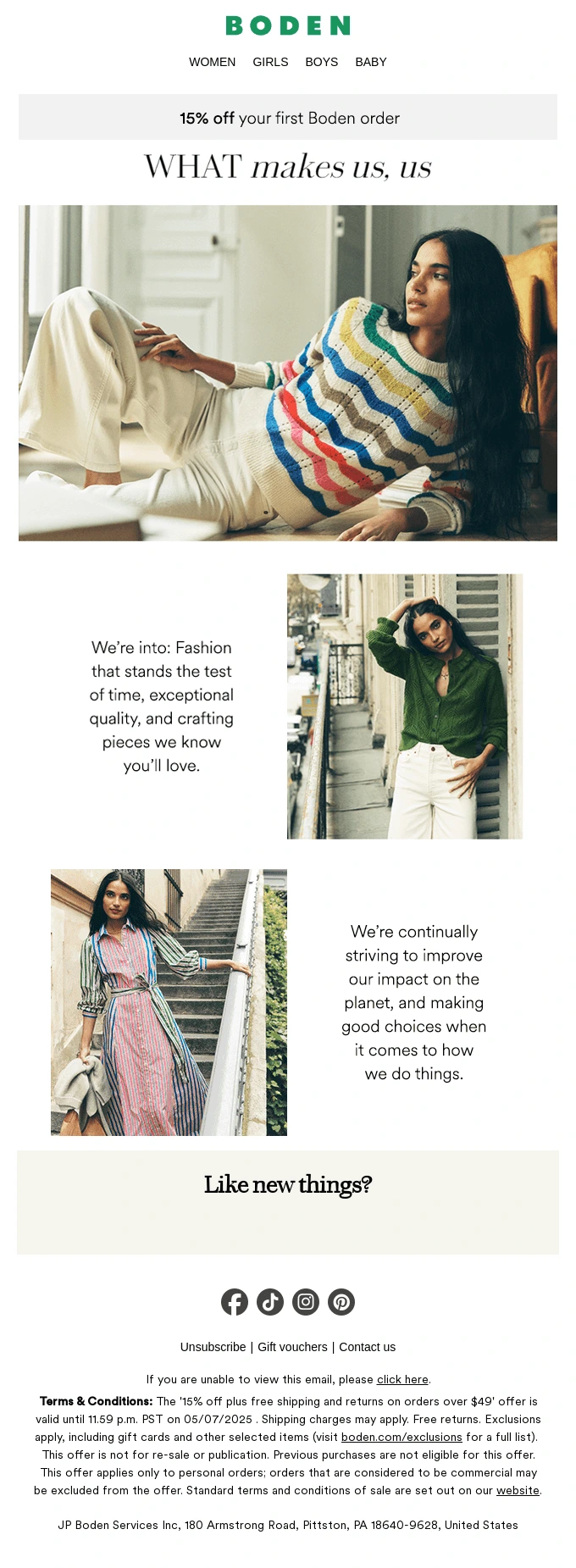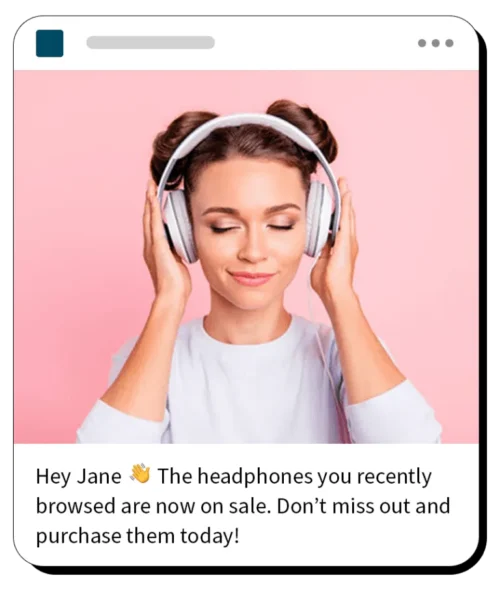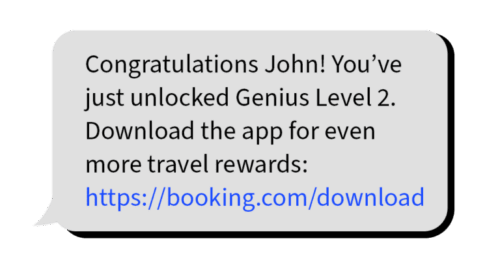Blog
Customer lifecycle marketing: Campaign examples and best practices
Published on February 16, 2024

Will Devlin

Capturing a customer’s attention is one thing. Keeping it is another. Today’s marketers know that long-term brand loyalty doesn’t come from a single interaction—it’s built over time, through a series of relevant, well-timed experiences. That’s the job of lifecycle campaigns.
Keep reading below for a breakdown of what customer lifecycle marketing involves, campaign examples from B2C brands, and best practices for turning one-time buyers into loyal, long-term customers.
What is customer lifecycle marketing?
Customer lifecycle marketing is the practice of tailoring marketing efforts to where a customer is in their relationship with your brand—whether they’re just discovering you, making their first purchase, or already a repeat buyer.
The strategy goes beyond the traditional conversion funnel. Instead of focusing solely on acquisition or individual transactions, lifecycle marketing addresses the full customer journey.
The goal: Maximize customer lifetime value (CLV), build deeper engagement, and strengthen brand advocacy through consistent, stage-aware messaging.
Why lifecycle campaigns matter?
The value of lifecycle campaigns lies in their ability to address customer needs as they evolve. When you meet people with the right message at the right moment, you’re nudging them toward an action as well as building trust and relevance over time.
Here’s what that translates into:
Increased customer retention
We all know the math: Keeping customers engaged post-purchase is way more cost-effective than constantly acquiring new ones. Lifecycle campaigns maintain that connection. They prevent customers from slipping away by providing ongoing value and consistently engaging them throughout the buyer journey.
Example: Five days after purchase, a skincare brand checks in with helpful usage tips.
A week later, they follow up with a soft recommendation for the next-step product. Two weeks after that, they ask for feedback—keeping the conversation going well beyond the sale and strengthening the relationship at every step.
These thoughtful touchpoints lower customer churn and safeguard the relationships you’ve worked so hard to establish.
Higher customer lifetime value
Lifecycle campaigns encourage repeat purchases by aligning with behavioral signals. Over time, these signals power increasingly relevant offers and communications.
Take a coffee chain: A new user signs up and instantly gets a 50% off voucher to encourage that first visit. After they redeem it, they’re invited to join the loyalty program. As they keep coming back, the app picks up on their ordering patterns—maybe it’s always a cappuccino on Tuesdays or a cold brew on Fridays—and starts serving up tailored offers based on those habits. That feedback loop turns casual visits into regular ones, building stronger engagement and driving higher spending over time.
Stronger brand loyalty
Customers stick around when they feel seen and understood. Lifecycle campaigns enable a more individualized experience—birthday perks, personalized refill reminders, helpful post-purchase support—so customers feel valued beyond the transaction. These touchpoints may seem small on their own, but together they form a brand experience customers are more likely to return to—and recommend.
The five stages of the customer lifecycle
Lifecycle campaigns work best when they align with the core stages of the customer journey. While the specifics vary by business, most B2C lifecycles follow this structure:
1. Awareness
The awareness stage is where potential customers first learn about your brand through lead sources like paid ads, organic search, website content, influencer mentions, etc. The goal here is to pique further interest with messaging that clarifies what you offer, the problems you solve, and why it’s relevant.
2. Engagement
Once aware, prospects begin exploring. They might browse your site, sign up for emails, or follow you on social. These early interactions are an opportunity to learn about preferences and behavior – and start tailoring communications accordingly. Track engagement signals like time-on-site, content views, and clicks to segment audiences and trigger follow-up campaigns that guide them closer to conversion.
3. Purchase
Even when intent is high, conversion can fall apart if the path is clunky. Slow sites, unclear pricing, or poorly timed messages can all lead to abandoned purchases. Lifecycle campaigns can reduce drop-off with abandoned cart nudges, first-time discounts, or live chat support that help seal the deal. At this stage, speed and clarity matter – messaging should remove hesitation, not add to it.
4. Loyalty
Once a customer makes a purchase, lifecycle marketing shifts to retention. Follow-up messages, satisfaction surveys, loyalty perks, and relevant product suggestions all contribute to keeping the customer engaged and coming back. You’re thanking them for buying – but also giving them reasons to do it again.
5. Advocacy
When customers consistently get value from your brand, some become vocal champions. Lifecycle campaigns can prompt reviews, reward referrals, or invite them into a brand ambassador program. These touchpoints help turn passive satisfaction into active promotion.
B2C lifecycle campaign examples
Different stages require different types of outreach. Here are some high-impact lifecycle campaign types in a B2C setting:
New customer campaigns
First impressions count. Start strong with a welcome series that introduces your brand and sets expectations. Instead of just offering a discount, use the opportunity to guide new customers toward their first high-value action.
Example: A fashion retailer sends a three-part email series that includes a welcome discount, a personalized lookbook based on browsing behavior, and a profile setup prompt to unlock better recommendations.

Winback campaigns
If a customer goes quiet, it doesn’t mean they’re gone for good. Winback campaigns can re-engage lapsed customers with targeted messaging that reminds them of what they liked about your brand – and why they should come back.
Example: A fitness app identifies users who haven’t logged in for 30+ days and sends a motivational push notification, followed by an email offering a free trial of premium features.

Abandoned cart campaigns
Cart abandonment doesn’t always signal disinterest. It can happen for a range of reasons – distraction, doubt, delivery fees. A well-timed reminder, coupled with clear product details, a small incentive, and even social proof, can help recover the sale.
Best practice: Tailor cart recovery messaging by cart value or LTV, and test messaging across channels to see which combinations perform best. Use urgency sparingly – relevance works better long-term than FOMO tactics.

App download campaigns
Encouraging customers to download your mobile app gives you a direct line for push notifications and in-app messaging – both powerful lifecycle tools. An SMS invite works well here, especially when paired with a personalized incentive.
Pro tip: Use SMS to follow up on in-store or online purchases with a prompt to download your app for loyalty tracking and exclusive deals.

Cross-channel lifecycle campaigns drive better results
Lifecycle campaigns perform best when they span multiple channels. Omnisend reports that customers who engage across three or more channels spend 13% more than single-channel users. That kind of revenue lift comes from consistency and context. Email, SMS, push notifications, in-app messages, and even direct mail all play different roles. The key is that they work together so messaging feels like a single, cohesive conversation with your brand.
Few Examples:
- A customer adds a pair of running shoes to their cart but doesn’t complete the purchase. A few hours later, they receive an email reminder with a nudge – “Still thinking it over?” – and a photo of the exact item they left behind. If the email goes unopened for 24 hours, an SMS follows up with a shorter, punchier message and a link straight back to their cart. This cross-channel approach keeps the brand top of mind without overwhelming the customer.
- A loyalty member finally hits the 100-point threshold needed for a free drink. Right away, they receive an in-app push notification with clear instructions on how to redeem it next time they visit. Later that day, they get a personalized email recapping their milestone – “You’ve earned it!” – along with a look at what rewards they’re close to unlocking next. It’s a moment of recognition that keeps them engaged and motivated to come back.
True personalization across channels is only possible with centralized, real-time data. Which brings us to the tech powering it all.
Powering lifecycle campaigns with MessageGears
Running lifecycle campaigns at scale requires the right infrastructure. MessageGears gives enterprise brands a structural advantage by eliminating the limitations of traditional marketing clouds. Instead of copying data to an external environment, you connect directly to your live data warehouse – so your campaigns run faster, smarter, and with fewer compromises.
Real-time access to live data
With MessageGears, you’re tapping directly into your brand’s source of truth. Marketers can build audiences and trigger campaigns based on up-to-the-minute behavioral and transactional data – without waiting on syncs or staging delays.
Enterprise-grade data security
Customer data never leaves your infrastructure. And because MessageGears operates within your secure environment, you retain full control over governance, privacy, and compliance – without compromising performance.
Built for scale and flexibility
Whether you’re sending millions of personalized emails or coordinating complex cross-channel journeys, MessageGears’ architecture separates processing from delivery. That means campaigns stay fast and reliable, even at enterprise volume.
Faster campaign execution
With full access to live data, marketers don’t need to rely on IT to build segments or sync new fields. Personalization is immediate, campaign logic is dynamic, and speed-to-market improves dramatically.
The result: Lifecycle campaigns that are more responsive, more secure, and more in tune with your customers’ behavior – at every stage.
Ready to turn your first-time buyers into loyal customers?
Book a demo to explore how MessageGears can help you build and scale smarter lifecycle campaigns across all your channels.